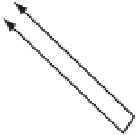Environmental Engineering Reference
In-Depth Information
5.1
Introduction
widely available while projects on TerraSAR-X announcement
of opportunity (AO) are running, projects on COSMO/SkyMed
AOs are about to start, and the Science and Operational Appli-
cations Research for RADARSAT-2 Program (SOAR) is also on
its way. The timescale is summarized in Table 5.1, where the
main features of some among the most important spaceborne
sensors are reported, along with their launch year. It can be noted
that a switch to the X band marked the achievement of 1-m
resolution.
Scientific research over data provided by the above new
generation sensors is also fully active, as shown by the increasing
number of publications. In this chapter, we will first see what sort
of information can be extracted on urban areas at the resolution
typical for older sensors, and then will move on to the new
generation, to highlight what new types of information can be
obtained. The focus will naturally be on the benefits of such
information extraction for urban area analysis. Some examples
of applications will be given and the benefits of SAR remote
sensing will be highlighted.
The peculiar characteristics of the urban environment were gen-
erally reflected in somehow complex characteristics of remotely
sensed data acquired over it. In optical images, for example, the
many different materials found within a small parcel (roof, vege-
tation, building materials, and so on) turn into a wide variability
of spectral responses over a small spatial stretch.
In radar images, the influence of material is limited, and
geometry of the target becomes more critical. Just to give an
example, Fig. 5.1 shows an example of backscattering range
profiles of a simple flat-roof building model. The building is
represented by a box with width
w
and height
h
, uniform surfaces
and flat surroundings, viewed by a synthetic aperture radar (SAR)
sensor with incidence angle
θ
.
In Fig. 5.1 the return from the ground is represented by letter
a
, while
b
highlights the double bounce caused by the corner
reflection created by the intersection of the building vertical wall
and the surrounding ground,
c
indicates single backscattering
from the front wall,
d
is the return caused by the building roof
and
e
represents the shadow area with absence of any return
from the building and from the ground. Symbols
l
[
l
5.2
Before spaceborne
high-resolution SAR
=
h
*cot(
θ
)]
and
s
[
s
h
*tan(
θ
)] represent the areas affected by layover and
shadow in the ground-projected image space, respectively.
The scattering effects of a gable-roof building and a flat-roof
building are different. The major difference is that a gable-roof
building has a second bright scattering feature, appearing closer
to the sensor than the double bounce, resulting from direct
backscattering caused by the part of the roof, which is oriented
toward the sensor.
Clearly, the complexity of the urban environment as seen
in the above examples, places several requirements on remote
sensors to be used. Spatial resolution, for example, is crucial,
because of the considerable variability and non-homogeneity of
urban areas even at small scales.
While optical satellite sensors have acquired data with as high
as 1-meter resolution in 1999 with the launch of IKONOS, only
several years later, satellite radar sensors were able to obtain data
with the comparable spatial resolution since the launches of the
German TerraSAR-X (Roth, 2003), the Italian COSMO/SkyMed
(Impagnatiello
et al
., 1998), the Canadian Radarsat-2 (Morena,
James and Beck, 2004) in 2007. Such data are becoming more
=
A SAR sensor generates the electromagnetic waves that illuminate
the target in a coherent manner, and collects the backscattered
field thus estimating the radar backscattering features of the
observed scene through complex processing of the collected
signal. This adds up to the inherent insensitivity to the presence
of water drops in the atmosphere, due to the long wavelength, to
form two clear advantages for radar data with respect to optical
data.
Notwithstanding these nice features, SAR sensors have not
been considered suitable for precise characterization of the
urban environment over a quite long period; until very recently,
very-high-resolution (VHR) optical data have been considered
somehow mandatory due to their efficient and reliable mapping
capabilities.
This does not mean that SAR sensors were not considered in
literatures. In fact, remote sensing papers explicitly considering
urban areas appeared as early as in 1990 (Bender, Gilg and Ottl,
c
d
b
a
a
h
e
θ
1
s
w
amplitude
a
+
c
+
d b
a
d
e
a
FIGURE 5.1
Along-range appearance of a very simple building in a SAR image.








































Search WWH ::

Custom Search